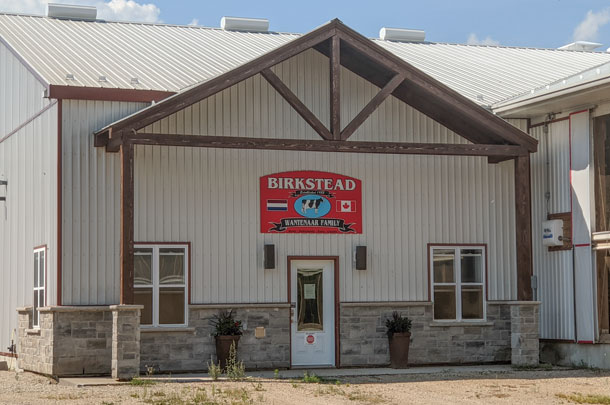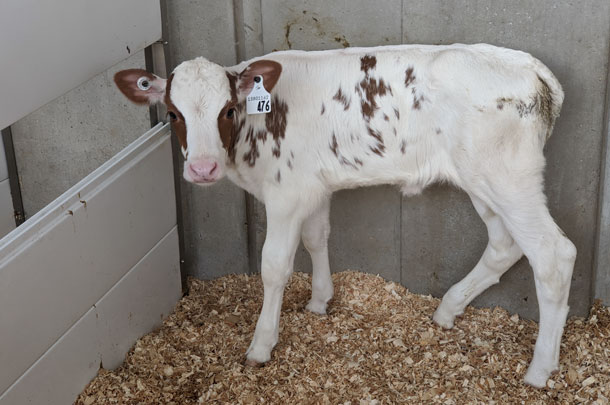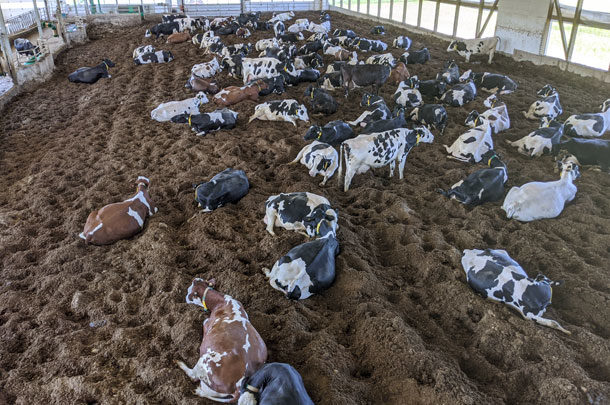When Wantenaar and his father started experimenting with crossbreeding their cows, they began crossing Holsteins with Brown Swiss and Jersey cows. The results of these crosses left much to be desired. Wantenaar says the Jersey crosses did not milk well, and the Brown Swiss crosses were stubborn and had poor longevity. “Early crosses didn’t last very long; they lasted a couple years, and we abandoned them and went back to purebred Holsteins,” Wantenaar recalls.
Following the return to Holsteins, a string of fertility issues led Wantenaar to once again begin crossbreeding his herd. “Our herd fertility was starting to go down. We were having a lot of cows having trouble with freshening and a bunch of other health issues. We attributed a lot of that to inbreeding, at least I did,” Wantenaar says. The benefits of crossbreeding were almost immediate, he adds. “As we kept crossbreeding, fertility kept going higher and higher in the herd.” In 2008, Wantenaar’s herd of purebred Holsteins had an annual pregnancy rate of 20%; this year that rate for the crossbred herd is 23%.
The difference was, instead of crossbreeding with Brown Swiss or Jersey cows, Birkstead Holsteins was crossbreeding their cows with Norwegian Red sires. Wantenaar was introduced to the breed around 2005 and was intrigued by the crossbreeding philosophy many apply to the breed. Wantenaar says they tried a few initial crosses at first and liked the progress and have been crossbreeding cows ever since. By 2010, it became normal practice for Wantenaar to crossbreed his Holstein cows with Norwegian Reds.

The purebred Holsteins on the farm were mostly bought as part of a recent herd expansion when Wantenaar could not find his desired crossbreeds. Wantenaar says he hopes the entire herd will be crossed eventually but notes the process will likely take five to seven years to come to fruition.
The mating criteria for Birkstead Holsteins’ crossbreeds is mainly based upon high milk production levels, as well as their Lifetime Performance Index (LPI). Wantenaar also breeds for the A2 characteristic in his herd, and although he does not test for it, he believes most – if not all – of his cows are A2.
Crossbreeding has also brought on several health benefits. Speaking about his herd’s health in recent years, Wantenaar says, “The health of the cows improved drastically. We still have cows that get sick, but before the cows would never get over it. … Now the cows get over it; they get better; they milk again; or they go dry and come back and milk again.” Birkstead Holsteins has not seen a single case of displaced abomasum in two years, and Wantenaar says cases of milk fever and clinical ketosis have all but disappeared. Wantenaar considers his herd to be “very low maintenance” in terms of healthcare needs.
Fertility-related disorders and calving have also improved as Wantenaar has continued crossbreeding. “Conception has been absolutely fantastic with the crossbreeds,” Wantenaar says. He notes he rarely sees cows with cystic ovaries in his herd. Unassisted calving has also become a very common event at Birkstead Holsteins, and Wantenaar says most of the crossbred cows begin milking at their full potential within a week of calving.
Wantenaar likes to keep track of his herd and uses his robots to help with this. He says, “I try to keep as much information here as possible.”
Looking at milk production, Wantenaar says his purebred Holsteins and the Holstein crosses produce roughly the same amount of milk. “I think if you use the best of each breed, they’re just as capable to milk as good as Holstein cows. When I break everything down, production seems to be pretty similar between all the different crosses.” He notes that while both purebreds and his crosses produce the same volume of milk, the Norwegian Red crossbred cows visit the robot more frequently, averaging 3.1 milkings per day compared to the average 2.8 milkings of Holsteins.

There have been a few challenges in the way of Wantenaar’s current crossbreeding achievements. He says it was difficult to get started because the bulls available at the time did not have very strong traits, but this has evolved and accessing good bulls has become easier. The current Norwegian Red and Holstein crosses are also crossed with a third breed of cow to maintain hybrid vigour. Wantenaar has tried several different breeds for this. He says Ayrshires produced the worst results, as milk production with those crosses were very poor. To address this, Wantenaar switched to Montbéliarde crosses, which worked well, but the genetics have become harder to find. At present, Wantenaar crosses the Norwegian Red and Holstein crosses with Fleckvieh cows, which he says are working well and have a good temperament.
So far, Wantenaar is very happy with the results of crossbreeding in his herd. He says it has made a big difference in terms of time spent treating cows and keeping them in good health. “At one point, it felt like we spent half the morning just treating cows; it just wasn’t fun.” He adds, “[Now] a cow will calve, and she’ll be off milking, and I don’t see her again until it’s time to breed her.” ![]()

-
Emma Ohirko
- Editorial Intern
- Progressive Dairy
- Email Emma Ohirko
PHOTO 1: Using the Lifetime Performance Index and milk production levels as mating criteria, Thomas Wantenaar decides which genetics to use in his herd.
PHOTO 2: Fertility issues on Thomas Wantenaar’s farm in Elora, Ontario, motivated him to crossbreed his cows.
PHOTO 3: Thomas Wantenaar tried several crosses before settling on the Norwegian Red breed. This calf is sired by a Holstein from a Norwegian Red and Fleckvieh cross. Photos provided by Thomas Wantenaar.








